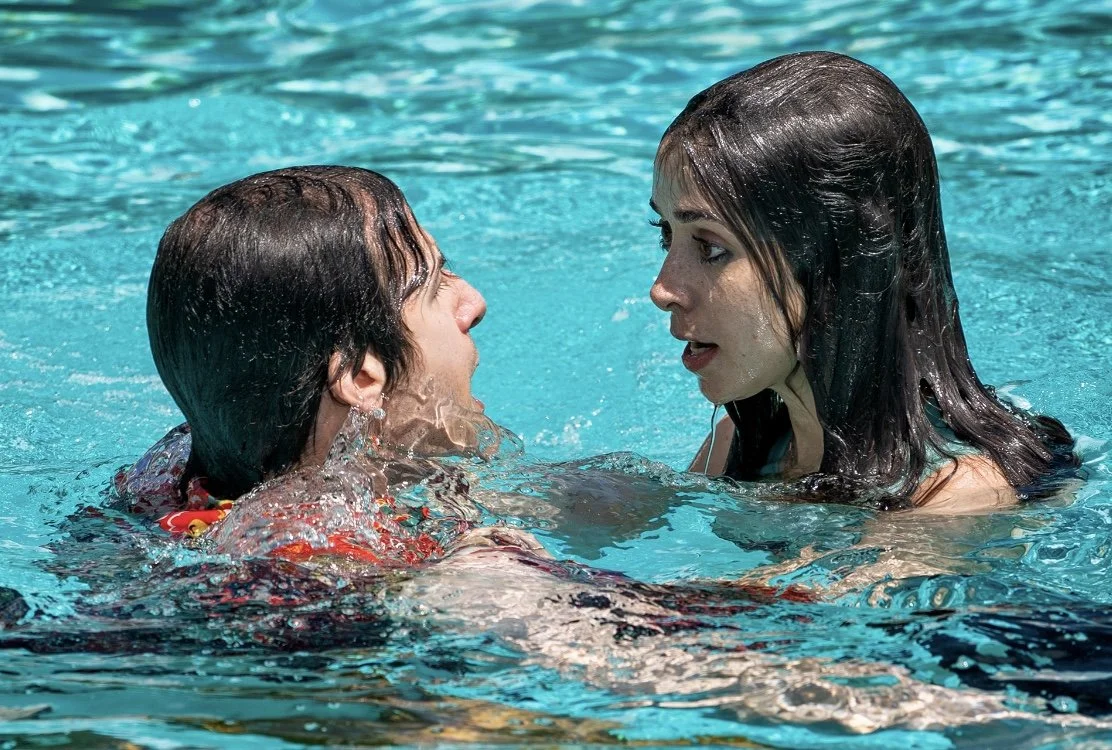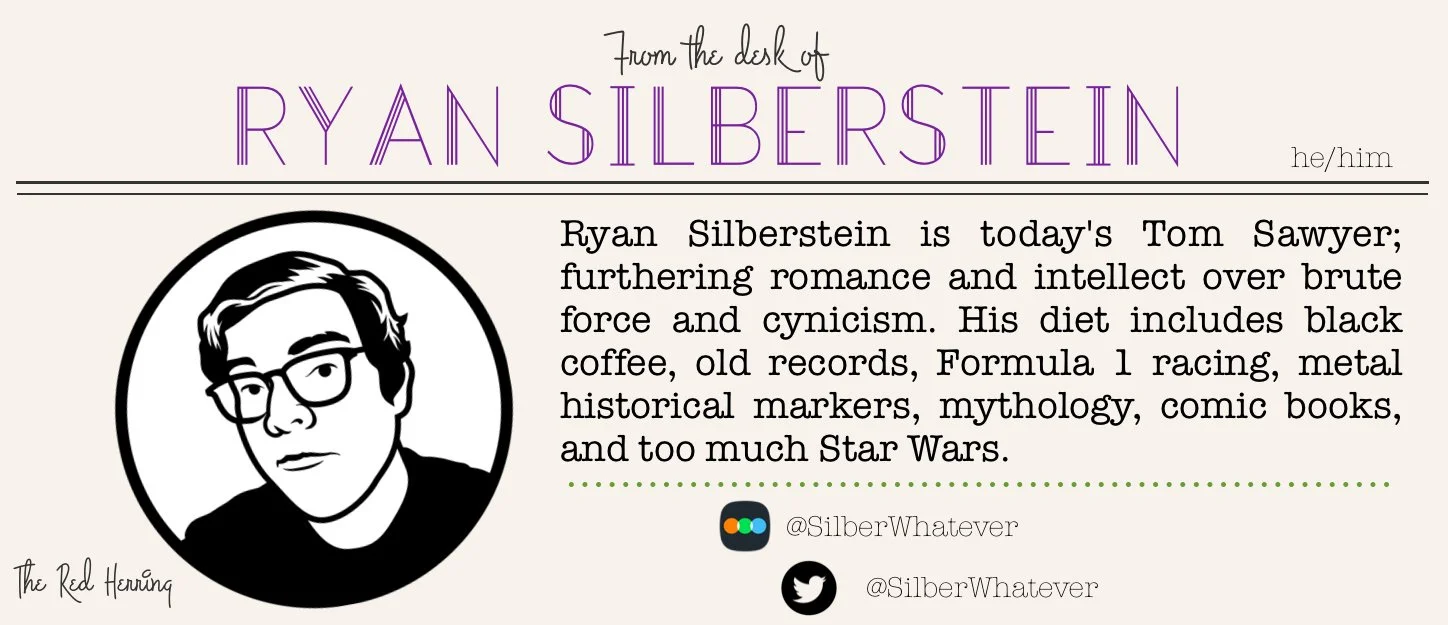Romance Week: Let's Do the Time Loop (Again)
by Ryan Silberstein, Managing Editor
“Enemies to lovers” can be a challenging set-up, especially for audiences (like me) who don’t have a ton of experience with romance as a genre. According to Romance Writers of America, any work in the genre must include these two elements: “a central love story and an emotionally satisfying and optimistic ending.” Within the genre, there are many common set-ups and tropes, often describing the arc of the central love story or the circumstances by which the two lovers unite (or reunite). One of the most infamous set-ups for this is the “enemies to lovers” plot, which features in classic stories like Much Ado About Nothing, Pride and Prejudice, and Jane Eyre.
Novels have an advantage over movies in telling this kind of story because they can unfurl based solely on the amount of space needed by the author to tell the story regardless of budget. Additionally, point of view in prose can also give the reader access to internal character development that can be harder to convey in visual media. And when a true “hero and villain to lovers” romance comes along, it can be hard for some in the audience to reconcile the trope.
Enter the time loop. Some of the more effective “enemies to lovers” romances in cinema use the science fiction trope of the time loop–a device wherein a character or characters are reliving the same time period over and over again (usually a single day) until they find a way to restore their linear time progression. Conceptually, time loops have been around for a while, but Groundhog Day popularized the concept in 1992. Conceived by Danny Rubin, with Harold Ramis doing rewrites and directing the film, it was successful upon initial release but took root in the culture so deeply it is essentially synonymous with the time loop concept.
Groundhog Day is Phil Connors’ (Billy Murray) and his evolution from self-loathing narcissist to someone who loves life and himself. This evolution occurs as Phil is reliving the same February 2nd in Punxsutawney, Pennsylvania over and over. As Phil repeats the same day seemingly without an end in sight, he goes through the five stages of grief (denial, anger, bargaining, depression and acceptance) and finally falls in love with Rita (Andie MacDowell). Someone as self-centered and self-important as Phil has a lot of work to do on themselves to truly change, and through extensive use of montage, audiences respond to Phil’s transformation–although it appears to have occurred overnight in the eyes of the other characters.
If Groundhog Day has a flaw, it is that so much of the movie’s runtime is devoted to Phil that it may not even seem like a romantic comedy until late into the third act. Love is ultimately the answer to the time loop’s riddle, and while I appreciate that Phil doesn’t end the time loop the first time he wins Rita, there is still something lacking. There’s not much of a relationship arc beyond the “enemies to lovers” description, but that is something pushed forward by other time loop romances that have been made since.
While Edge of Tomorrow (also known as Live. Die. Repeat.) is not a romantic comedy, it still features both a time loop and a romance. Building off the Groundhog Day formula, Edge of Tomorrow makes its Rita (Emily Blunt) a former time looper herself, so when she meets Cage (Tom Cruise), he is able to convince her what is happening to him. From there, this mutual understanding allows a relationship between them to develop, even if Cage has to spend the first chunk of every loop catching Rita back up to speed (and she initially hates him every time she meets him). Again, we follow the character development of the man protagonist caught in the time loop with a woman leading him out of it. While Edge of Tomorrow is much more of a science fiction action film at its core, there are enough romantic comedy elements to center the “enemies to lovers” trope.
The same applies to Happy Death Day, which also combines a time loop, a central romance, and another genre–in this case, the slasher. Tree (Jessica Rothe, who should be cast in literally everything) is caught in a time loop on her birthday, waking up the dorm room of a boy she doesn’t know each time the day resets. Carter (Israel Broussard), the boy in question, offers to use his knowledge of pop culture and science to help, as most of Tree’s loops end with her being murdered. Carter is a bit bland in the same way that Groundhog Day’s Rita is, but Tree’s relationships with other characters are just as impactful. The Groundhog Day set up is gender swapped here, so looking at it from a gendered lens means that Tree has a lot more character development than (either) Rita, just by virtue of the structure. But Happy Death Day also goes another step further. Adding in the “who-doing-it” of Tree’s repeated murders also means that Tree doesn’t quite have the same arc on the way to her redemption as Phil Connor’s day. She is already a woman grieving, and her refusal to get close to people after her mother’s death gives her arc a more definitive resolution than Phil or Cage.
Premiering at the 2020 Sundance Film Festival before arriving on Hulu in the midst of pandemic lockdown, Palm Springs has become so associated with that time period that it may be overlooked for the ways it uses the time loop as a metaphor for modern life. Here the Groundhog Day formula is pushed further along, as Nyles (Andy Samberg) is trapped in the same day with both Roy (J.K. Simmons) and Sarah (Cristin Miliotti). While Roy only occasionally shows up in Palm Springs, Sarah and Nyles wake up in the same rented house each morning as Sarah’s family gets ready for her sister’s wedding.
The innovation of having both romantic partners in the same time loop means we experience both characters’ arcs. Palm Springs opens in media res for Nyles, who has been comfortably within the same day for…a long time (he may not even remember what he does for work), but we see Sarah get pulled into the loop and watch her emotionally reconcile with what that means for her. While this means we see less of the same events repeated compared to the three other films above, it gives us much more insight into Sarah and Nyles, which makes it the strongest romantic angle overall.
While I find all of these movies emotionally moving for one reason or another, Palm Springs lands hardest for me, especially on a recent rewatch. While all of these time loop stories are really about “living every day to the fullest,” Palm Springs is the only one that acknowledges how hard that is just in terms of being alive. While Phil, Cage, and Tree all have emotional baggage that makes them reviled by those around them, Nyles’ fatalistic acceptance and Sarah’s earnest need to find a way to love herself resonates the most. These are characters who want to be better, but don’t understand how to do that (Roy also fits right in with them in his own way).
All of these stories are optimistic about being able to start over, one day at a time, until we actualize into the person we want to be. When we view ourselves as the “enemy” in the “enemies to lovers” trope, we can see a path for growth laid out before us. We always need to work to be our best selves, even if that growth path is not as neat or linear as the movie script. That labor starts with not only recognizing our flaws, but choosing to understand why we cling to the behaviors and attitudes we do not love in ourselves and starting the work to be better. It’s never too late to start over, even if none of us have the luxury of resetting the day ad infinitum with the benefit of no one else remembering what happened. We have to choose to be better each day, for ourselves and the people we want in our lives. And that lesson feels like one of the hardest of all. But it helps knowing it is possible to get it right.





